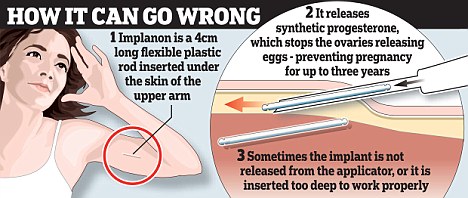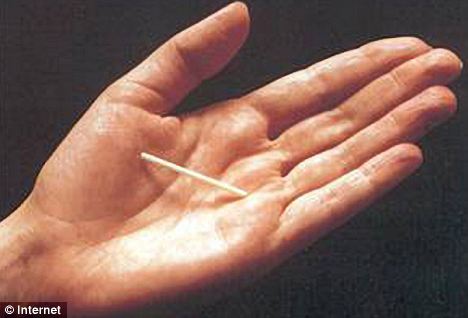
Fertility fears for hundreds of women after reports removable contraceptive implants can go 'missing' inside their bodies
Claire Bates
- Implanon device contains a progesterone-like hormone that is released slowly into the bloodstream
- MHRA said there have been 36 reports of the device moving from its original location and five reports of infertility due to problems finding the device
- Older women could now be left with no chance of having children
Hundreds of women may have had their fertility put in jeopardy after reports that a popular contraceptive implant could get 'lost' in their bodies.
The problem with the Implanon device could also force hundreds more to delay their dreams of motherhood.
The implant, which is used by hundreds of thousands of women in the UK, is the size of a matchstick and is inserted under the skin of the upper arm, in a procedure that needs to be carried out by a trained doctor.
After use, the deviceis meant to be removed. It can also be taken out of the body sooner if the woman desires to try and get pregnant, or for health reasons.
However, according to theMedicines and Healthcare Regulatory Agency – the Government’s drugs and medical devices watchdog, dozens of cases have been reported where the implant had moved from its original allocation.

The Implanon implants slowly release a hormone into the bloodstream which gives contraceptive protection for three years
Plus a number of worried women have revealed on online forums that doctors have been unable to locate their implants - raising fears they may never be able to conceive.
Over three years Implanon releases the hormone progesteroneinto the blood, which stops the ovaries from releasing eggs and makes the womb less receptive. The rod, which is made from a biodegradable synthetic material,is supposed to be easily implanted and removed.
However, figures released to Mail Online have revealed that up til August 2012, a total of 2,314 spontaneous suspected adverse drug reactions had been reported associated with Implanon and its successor Nexplanon.
This included 36 spontaneous reactions of devices moving from their original site and five cases of infertility where the Implanon device could not be located for removal.
However, the MHRA added the numbers could be far higher due to under-reporting and a number of worried women have posted their problems with the device on online forums.
A forum user called Claire T, posted on Netmums: 'Has anyone else had a problem with their implanon going missing?
'I went to have mine removed 5 months ago but the doctor couldnt feel where it was so sent me for an ultrasound which didn't find it so i am now waiting for an MRI scan to see if that picks it up.
'I'm so worried it will never be found!'
Kelly W replied she had the device in for 18 months. Adding: 'When I had it out it had moved an inch up my arm from the original scar.
'The doctor said that it was really odd because fatty tissue keeps it where its inserted almost instantly. He really was shocked.'

Problems: A number of women say they have become pregnant despite having the implant
THE £90 DEVICE USED BY AROUND 800,000 WOMEN
Licensed in 1999, Implanon has become a popular form of contraception, with around 800,000 women using it, according to Department of Health estimates.
The £90 device is a flexible rod the size of a matchstick that is inserted under the skin of the upper arm. It gradually releases the hormone progesterone which stops the ovaries from releasing eggs and makes the womb less receptive to fertilised eggs.
It provides protection against pregnancy for up to three years and properly inserted it is 99.95 per cent effective among all users, compared with 99.7 per cent for the Pill.
But investigations showed in some cases the implant was not released from the pre-loaded applicator and never inserted into the arm of the patient. In other women it was delivered too deep to work properly.
One in four women who go to family planning clinics get long-term contraceptive implants. They are especially popular with teenagers, with 10 per cent of 16 to 19-year-olds saying they prefer an implant because they do not have to remember to take a pill.Around 80,000 women use implants of the same type as Implanon.
Meanwhile Nici Davies, 37, from London, was offered the implant in 2010 and said she was told it could easily be removed when she wanted children.
However, when she requested it be taken out this April she said three different doctors failed to find the device. She is awaiting a scan but has been warned the device may never be found.
She told The Sun: 'The implant can last five years. I am left with no chance of having children.'
She added: 'Why do they push implants for older women if they know this can happen?'
Implanon’s manufacturer MSD, a subsidiary of global pharmaceutical giant Merck, replaced Implanon in 2010 with an updated product called Nexplanon, which has a new pre-loaded applicator and contains barium so it can be better detected.
However, it has not recalled the existing stock of Implanon, meaning women are still being given it.
In a statement the MHRA said: 'Rare cases of migration with Implanon and the difficulty of removal was one of the key reasons for developing a radio-opaque version of Implanon, called Nexplanon.
'Nexplanon was introduced in the UK in 2010 and can be identified using X-ray or CT scan in the rare cases that it cannot easily be located in the usual way.
'As with all medicines, the MHRA will continue to monitor the benefits and risks of Implanon and Nexplanon. We would advise anyone with questions about their contraceptive implant to speak to their GP.'
It is the latest setback for the contraceptive method, which is manufactured by Merck,after data from 2011 revealed almost 600 women using the device found they still became pregnant.
Despite this, the Department of Health has advised there is no cause for concern with the devices. They said no form of contraceptive is 100 per cent effective and anyone with concerns should visit their GP.

The device is just over an inch long and doesn't show up under X-rays
The MHRA said there had been reports of problems with inserting and removing Implanon. However, it advises that women who can feel their implant and within the three-year timeframe do not need to take any action.
Lynn Hearton Helpline and Information Services Manager the sexual health charity FPA said: 'It’s highly unlikely that implants migrate around the body. But very occasionally they’re fitted too deeply.
'There are specially trained doctors who can take them out. Women who’ve got an implant can be easily reassured it's still in place by feeling it under their skin. If they can’t they should get it checked out or phone us for advice.'
A spokesman for Implanon's U.S manufacturer Merck, said 'On the rare occasion that the implant cannot be located by the doctor or nurse feeling for the implant prior to its removal, there are various methods which can be used to help locate the implant such as ultra-sound scanning and MRI.
'Unlike Implanon, Nexplanon contains barium sulphate which means that it can be detected by x-ray and CT in addition to ultra-sound and MRI.
'We would always advise women to contact their healthcare professional or call the implant helpline number on the user card given to women when they have the implant inserted.'
